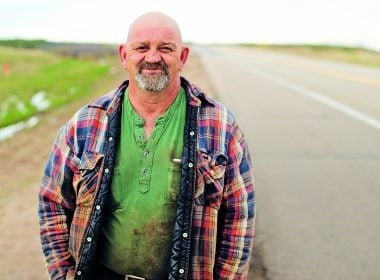
Maurice Poirier has driven northern Alberta’s Highway 63 nearly every day for the past two years. He’s never grown comfortable with it. The 450-kilometre corridor between Edmonton and Fort McMurray buzzes with passenger vehicles, workers commuting to the oil sands, and transport trucks delivering equipment and supplies to the mining camps. Most motorists are in a rush, says Poirier, 56, a mechanic’s assistant witha shaved head and goatee who spends most of his days driving between job sites as part of a road crew. “I fear that highway.”
Traffic was heavy on the evening of August 26, 2013. Poirier had finished his 12-hour shift around 7:30 p.m. and was driving his Dodge Ram southbound on 63 to his temporary home-a fifth wheel trailer parked in a farmer’s field. He put on his blinker to signal a left turn off the two-lane highway and came to a stop to wait for a break in northbound traffic. Poirier checked his rear-view mirror and noticed a cube van slowing down behind him. Moments later, the van accelerated onto the shoulder. Poirier next heard squealing brakes, followed by the noise of broken glass and sheared metal.
He bounded out of his truck. The van, he realized, had veered off the road to avoid being hit by a southbound semi-truck that had braked at the last second, causing the twin tankers it was hauling to jackknife, blocking most of the highway. A northbound SUV had slammed into the side of the semi, rupturing its fuel tank and spilling diesel on the road.
The accident immediately backed up traffic in both directions. Beside the SUV, a woman was yelling for help. As Poirier rushed over, he noticed flames licking from under the crumpled hood.
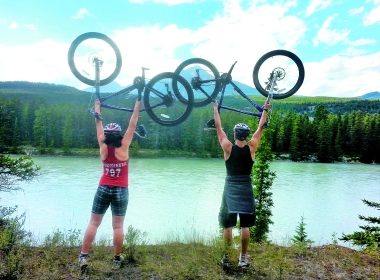
Road trips are a tradition for the Scantleburys. They’ve driven across Canada and from Toronto to New Orleans for a winter vacation. “We have lots of time to catch up when we’re all stuck in a car,” laughs Jeanny, an educational consultant. Now the family was in transition: Zoë was getting an extended taste of the work world, and Malcolm, 19, was set to begin his first year at the University of Ottawa. “If we hadn’t gone out to Alberta, we wouldn’t have seen Zoë until Christmas,” says Patrick, a designer of heating and cooling systems.
Patrick, Jeanny and Malcolm flew to Edmonton, rented a Ford Escape SUV and picked up Zoë in Fort McMurray. They drove across the Rockies and laid over in Jasper National Park on the return trip. Patrick’s happiest memory of the trip happened on the second-last day, when the family mountain biked Jasper’s alpine trails in the late summer sun. Atop a bluff overlooking the turquoise waters of the Athabasca River, Patrick asked his children to pose for a photo. Silhouetted against a mountain backdrop, Zoë and Malcolm, standing five foot nine and six foot two, respectively, lifted their bikes overhead. For Patrick, it was a poignant reminder his kids were growing up. “It was bittersweet,” he recalls.
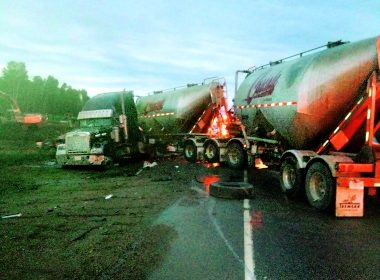
The family departed Jasper to return Zoë to her company housing in Fort McMurray. Following a stop at the West Edmonton Mall, Patrick drove north on Highway 63. During her time in the oil sands, Zoë had heard stories about the “Highway of Death,” as the route is known by Albertans. Since 2005, there have been 44 fatal accidents on the 180 kilometres of Highway 63 found within the Boyle RCMP Detachment, north of Edmonton. Mounties responded to 235 collisions in 2013 alone. The road has hills, bends and erratic weather, but its greatest danger is the ever-increasing volume of traffic.
Around 6:30 p.m., Jeanny took a turn behind the wheel. The day had become overcast, and a light drizzle started to fall. Zoë sat beside her mother up front, while Patrick and Malcolm dozed in the back seat. All Jeanny remembers about the moments leading up to the accident is Zoë screaming “Mom!” as a silver curtain suddenly spread across their lane.
The collision jolted Malcolm awake. “It was the biggest impact I’ve ever felt. My whole torso tightened up,” he says. He heard his mother open her door and rush out of the vehicle, then saw her help his dad out of the back seat. “Are you okay?” she then asked her son. Other than blurry vision and burns from the seat belt, Malcolm felt fine. Then he glimpsed Zoë’s limp body resting in an unnatural diagonal position in her seat. Intense heat radiated from the front. He realized his parents would need help extracting his sister, but his seat belt was seized. “I need a knife!” shouted Jeanny. “My son is stuck!”
Maurice Poirier arrived on the scene. It was a desperate situation: the SUV was crumpled, its windshield shattered and the front pillar staved in 40 centimetres on the passenger side, near Zoë’s head. Worst of all, a fire raged in the engine compartment. Poirier decided to focus on Malcolm. “He was awake,” he says. “I thought I had a better chance of freeing him first.” Pulling out his pocket knife, Poirier scrambled into the vehicle and sliced through Malcolm’s seat belt. He then ran to his truck for a fire extinguisher.
Standing in the road, Malcolm watched his father, Patrick, clutch his abdomen and groan in pain as he tried to wrench open Zoë’s mangled door. The air reeked of burned brakes and rubber.
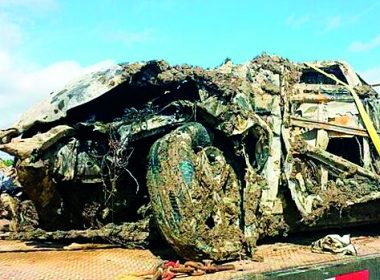
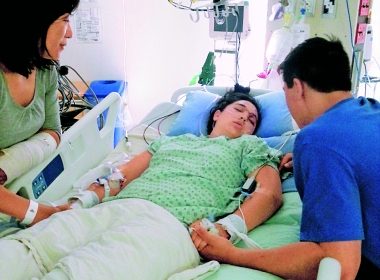
Malcolm watched from the roadway, where he paced between his father, hunched down on the ground behind the tanker, and his wide-eyed mother. With lungs full of air, Poirier once again reached into the front seat, grabbing for Zoë’s arms and torso, but he couldn’t manoeuvre her body around the bent frame of the car. When his extinguishers were empty, Overacker stepped in. Finally, Poirier and Overacker dragged Zoë out, her head and face covered in gruesome cuts, and carried her to the other side of the highway.
The SUV reignited, but Poirier turned his attention to an even bigger threat: the tankers. He was unsure whether they were full or empty, but whatever they held-liquid or fumes-risked exploding. Combined with the pool of diesel creeping close to the burning car, the site was riddled with time bombs. Jeanny, Malcolm, Overacker and other bystanders circled around Zoë, while Poirier climbed back in his truck and shifted into four-wheel drive. The truck shuddered as Poirier rammed the burning SUV into the ditch.
The immediate dangers had been addressed, the passengers removed and the risk of explosion averted. But for Poirier, a veteran driver of this remote stretch of highway-in the hinterlands of northern Alberta, at least an hour from the nearest hospital in Lac La Biche-the prospect of a potentially lengthy wait for professional help was a more insidious concern.
“Look at her head!” Jeanny screamed, clutching her unconscious daughter, who lay on a bed of clothing and blankets on the side of the highway. “Her head’s dented!”
As Jeanny became increasingly panicked, Poirier did his best to minimize her distress. He asked a bystander for a bottle of water, then removed his baseball cap, turned it inside out, saturated it and gently pulled it over Zoë’s head, hoping to slow the bleeding and hide the wounds. Then he held the young woman’s hand. Speaking slowly in Zoë’s ear, he asked if she could squeeze his fingers. Her grip tightened and released in spasms-a positive sign. “Don’t worry,” Poirier reassured Jeanny, “she’s responding. She’s just in shock.”
When Zoë started moving, grasping haphazardly at the wounds on her face and ears with her hands, Poirier bridged his body over Zoë’s so she couldn’t reach her head. “I told her to scratch and pat my back,” Poirier says.
It began drizzling again. Then, about 45 minutes after the crash, just as dusk fell and hordes of mosquitoes emerged from the surrounding woods, three ambulances arrived.
The Scantleburys were transported to the hospital in Lac La Biche. From there, Zoë was rushed to Edmonton’s University of Alberta hospital by helicopter. Patrick’s internal injuries-he suffered broken ribs and perforated intestines-demanded acute care, and though Malcolm only displayed abrasions and friction burns from the seat belt, paramedics surmised he may have suffered head trauma as well, so father and son were also airlifted to Edmonton. Jeanny was treated for a broken wrist in Lac La Biche. (The next day, August 27, a victim-services organization helped reunite Jeanny with her family in Edmonton.) Once the wreckage was cleared and police reports filed, Poirier drove away, shaking from the intensity of the rescue.
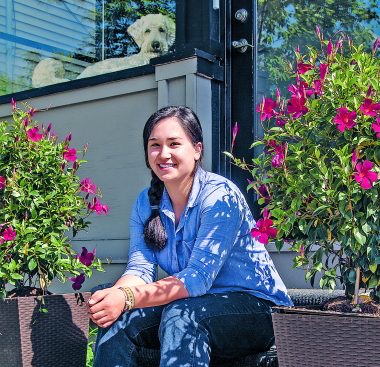
In the first days after the accident, no one spent more time at Zoë’s bedside in Edmonton than Malcolm. His sister was in a coma. The impact to her head had caused diffuse axonal trauma, a brain injury that left her unable to breathe on her own. The doctors worked to control the swelling that compromised her body’s ability to perform basic functions, while also treating three brain bleeds. As well, Zoë suffered a fractured skull, a broken nose and several broken teeth, including cuts on her face that required 37 stitches.
Malcolm was worried for his sister. Their time together on the road seemed like a turning point in their relationship. “We were closer than ever,” he says. “I knew Zoë might never be the same. That scared me.”
After a week, Malcolm reluctantly left to start his first year of kinesiology studies in Ottawa. Then he received a message from his father: after nine days in a coma, Zoë was breathing on her own. A few weeks later, Patrick emailed Malcolm a video of Zoë playing piano at the hospital. She stayed in Edmonton for six weeks before being transferred to a Toronto hospital. “It’s amazing to see how she recovered,” says Malcolm.
After a year of rehabilitation, including neurological, speech, physical and occupational therapy, Zoë is looking forward to starting her fourth year at Queen’s University. Because her brain may be more susceptible to injury from impacts, it’s doubtful she’ll ever play her favourite contact sports-like roller derby-again. Otherwise, she’s nearly back to normal. “I’m still working on my smile,” she laughs. “My lip is a little droopy.” She felt tired and sluggish over the winter months but took a Spanish course, with the hope of one day working as a geologist in South America. She now has Charlie, a goldendoodle puppy, to accompany her on walks.
Despite Zoë’s recovery, Patrick still clings tightly to the image of his children, strong and healthy, in Jasper. His and Jeanny’s gratitude for the good Samaritan motorists on Highway 63 hasn’t wavered. “People put their lives in danger to help my family,” says Patrick.
Last September, shortly after Zoë emerged from her coma, he asked Poirier to visit them in the hospital. “I told my boss, ‘I’m going to Edmonton to check on them,'” says Poirier. “I could barely recognize Zoë. I was in tears when I saw her mother and father.”
Poirier still gets emotional driving past the crash site, knowing just how close he came to witnessing tragedy. “I never want to go through it again,” he says, “but I wouldn’t hesitate to do the same thing.”